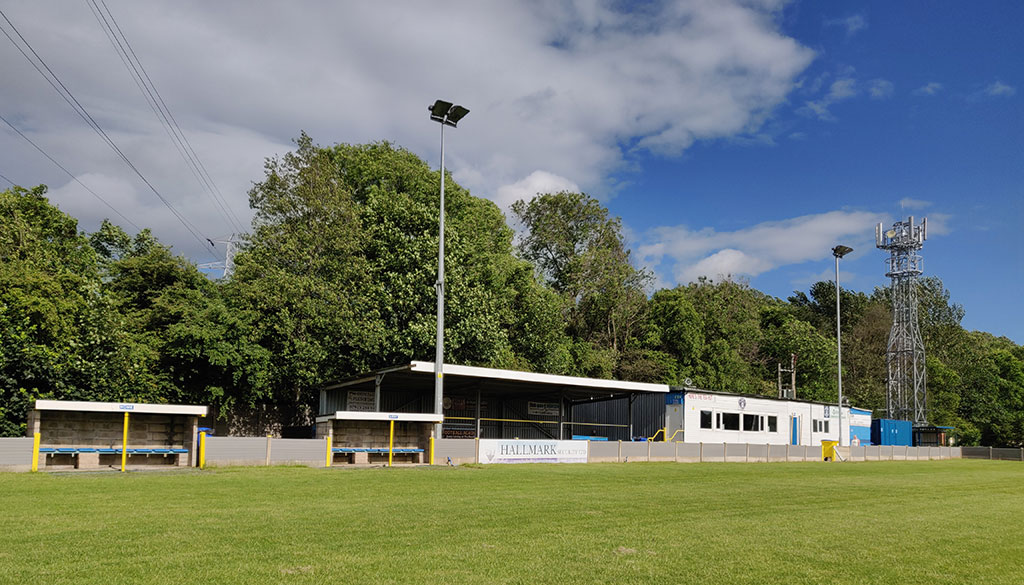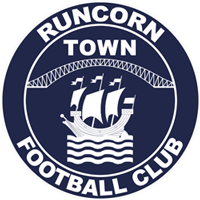
Emblematically Speaking - Runcorn Town
Tue 17th April 2018 | Runcorn Town | By Stewart Taylor
The development of this club emblem is relatively recent and follows a perhaps not unfamiliar story.
Recognising that the club needed a new emblem, one of the committee commissioned one of his relatives to come up with some ideas, although commissioned might be too grand a word to describe the process in this case.
Let’s just say that he was asked and, in due course, came up with around eight possible designs for the committee of the football club to consider. This they duly did and the result is what we see today as the club emblem of Runcorn Town FC.
Recognising that by now regular readers of these articles will have gained significant knowledge of the “art” of interpretation of football club emblems, I could be tempted to leave it right there and invite you, the reader, to develop the story.
However, kind and generous soul that I am, I will have a go and then you can see if you agree.
Here we see a roundel design and the name of the organisation it represents is very clearly spelt out.
The predominantly blue colour of the emblem represents the navy blue element of the playing kit. And then we have some devices which warrant further thoughts.
The main feature is a sailing ship on white and blue waves. Incidentally, wavy lines of this nature, which we have seen before in this series of articles, are known as a “fountain” in heraldic terms.
This is a powerful device bringing to mind many aspects of the town of Runcorn, not least the significance of the shipping industry to the town. An insight into the significance of sailing ships to Runcorn can be understood from this passage:
Years ago the Docks at Runcorn and Weston Point were mostly used by sailing schooners, which traded to all parts of the British Isles, the continent, and Newfoundland.
The crews of these small vessels consisted of from 4 to 8 men according to the size and tonnage of the vessel. Many Runcornians sailed in these ships, some of them graduating to become Masters.
In those days the Docks at Runcorn and Weston Point were full of ships, both sail and steam coasters, and it was possible to cross from one side of the dock to the other on the decks of the sailing vessels.
Life was hard and dangerous and many local seamen lost their lives serving in these ships.
This is taken from a series of articles known as Joe’s Jottings, written by Joe Broady of Runcorn, who was born in 1906.
That there are four white lines in the fountain, could well be indicative of four waterways which are important to the town of Runcorn. These are the Manchester Ship, Bridgewater and Runcorn & Weston Canals, the latter of which was built to connect the nearby River Weaver to Runcorn Docks. The fourth waterway being our old friend the River Mersey.
In addition to that, the device provides a link with the origins of the football club in that the fountain is from the Mond Crest.
This symbol is believed to have been the origin of the ICI Mark. The star and fountain display the connection of Brunner, Mond and Company, the predecessors of ICI.
The significance of the town of Runcorn to the development of the chemical industry in this country is well understood.
However, the significance to the football club is that the origins of the current Runcorn Town FC can be traced back to a works team from the local Castner Kellner Works – a factory established in the 1890s at Weston Point to manufacture caustic soda.
The factory was taken over by Brunner Mond in 1920 and became part of the formation of ICI in 1926.
The remaining device is a representation of the Jubilee Bridge – perhaps better known as the Runcorn – Widnes Bridge – which crosses the River Mersey and the Manchester Ship Canal. This bridge, opened in 1961, replaced the old Transporter Bridge.
As we know, Runcorn is part of the Borough of Halton these days and the subject of "the bridge" is currently a much discussed topic amongst Halton residents.
The new Mersey Gateway Bridge was opened on October 14th last year and, on the same day, the Jubilee Bridge was closed. The controversial point is that the new bridge is tolled as will be the Jubilee Bridge when it is re-opened after some much needed maintenance work.
It is not the role of these short articles to get involved in local politics, but the tolling of both bridges is a topic of some resentment to both locals and those from further afield, who use the bridge as a link between Cheshire and Lancashire.
So that’s the story and, again, a demonstration of how a few, seemingly simple, devices can tell us a great deal about what an emblem represents.
With thanks to Martin Fallon of Runcorn Town for his help in putting together this article.
 Emblematically Speaking - Runcorn Town
Emblematically Speaking - Runcorn Town
Tue 17th April 2018 | Runcorn Town
By Stewart Taylor

The development of this club emblem is relatively recent and follows a perhaps not unfamiliar story.
Recognising that the club needed a new emblem, one of the committee commissioned one of his relatives to come up with some ideas, although commissioned might be too grand a word to describe the process in this case.
Let’s just say that he was asked and, in due course, came up with around eight possible designs for the committee of the football club to consider. This they duly did and the result is what we see today as the club emblem of Runcorn Town FC.
Recognising that by now regular readers of these articles will have gained significant knowledge of the “art” of interpretation of football club emblems, I could be tempted to leave it right there and invite you, the reader, to develop the story.
However, kind and generous soul that I am, I will have a go and then you can see if you agree.
Here we see a roundel design and the name of the organisation it represents is very clearly spelt out.
The predominantly blue colour of the emblem represents the navy blue element of the playing kit. And then we have some devices which warrant further thoughts.
The main feature is a sailing ship on white and blue waves. Incidentally, wavy lines of this nature, which we have seen before in this series of articles, are known as a “fountain” in heraldic terms.
This is a powerful device bringing to mind many aspects of the town of Runcorn, not least the significance of the shipping industry to the town. An insight into the significance of sailing ships to Runcorn can be understood from this passage:
Years ago the Docks at Runcorn and Weston Point were mostly used by sailing schooners, which traded to all parts of the British Isles, the continent, and Newfoundland.
The crews of these small vessels consisted of from 4 to 8 men according to the size and tonnage of the vessel. Many Runcornians sailed in these ships, some of them graduating to become Masters.
In those days the Docks at Runcorn and Weston Point were full of ships, both sail and steam coasters, and it was possible to cross from one side of the dock to the other on the decks of the sailing vessels.
Life was hard and dangerous and many local seamen lost their lives serving in these ships.
This is taken from a series of articles known as Joe’s Jottings, written by Joe Broady of Runcorn, who was born in 1906.
That there are four white lines in the fountain, could well be indicative of four waterways which are important to the town of Runcorn. These are the Manchester Ship, Bridgewater and Runcorn & Weston Canals, the latter of which was built to connect the nearby River Weaver to Runcorn Docks. The fourth waterway being our old friend the River Mersey.
In addition to that, the device provides a link with the origins of the football club in that the fountain is from the Mond Crest.
This symbol is believed to have been the origin of the ICI Mark. The star and fountain display the connection of Brunner, Mond and Company, the predecessors of ICI.
The significance of the town of Runcorn to the development of the chemical industry in this country is well understood.
However, the significance to the football club is that the origins of the current Runcorn Town FC can be traced back to a works team from the local Castner Kellner Works – a factory established in the 1890s at Weston Point to manufacture caustic soda.
The factory was taken over by Brunner Mond in 1920 and became part of the formation of ICI in 1926.
The remaining device is a representation of the Jubilee Bridge – perhaps better known as the Runcorn – Widnes Bridge – which crosses the River Mersey and the Manchester Ship Canal. This bridge, opened in 1961, replaced the old Transporter Bridge.
As we know, Runcorn is part of the Borough of Halton these days and the subject of "the bridge" is currently a much discussed topic amongst Halton residents.
The new Mersey Gateway Bridge was opened on October 14th last year and, on the same day, the Jubilee Bridge was closed. The controversial point is that the new bridge is tolled as will be the Jubilee Bridge when it is re-opened after some much needed maintenance work.
It is not the role of these short articles to get involved in local politics, but the tolling of both bridges is a topic of some resentment to both locals and those from further afield, who use the bridge as a link between Cheshire and Lancashire.
So that’s the story and, again, a demonstration of how a few, seemingly simple, devices can tell us a great deal about what an emblem represents.
With thanks to Martin Fallon of Runcorn Town for his help in putting together this article.


